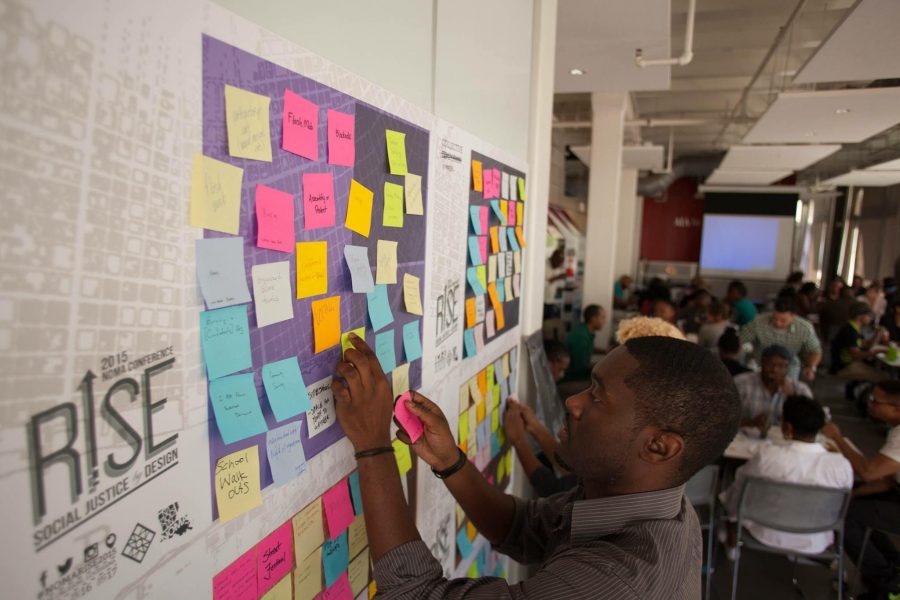Artistic minds gather for Design As Protest on Inauguration Day
Photo Courtesy of Bryan C Lee Jr.
Bryan C Lee Jr. puts up post-it notes at a Design as Protest workshop in New Orleans. Design as Protest brings together artists, architects, and designers to address social injustices.
Jan 18, 2017
Last updated on Jan. 20, 2017 at 11:53 a.m.
Inauguration day is fast approaching, and Design As Protest: National Day of Action will be held in response.
Bryan Lee, place and civic design director for the Arts Council of New Orleans, is one of many individuals who, through a series of workshops in cities across the country, will be partaking in the national day of protest on Friday.
Lee, an advocate and activist for social justice, along with several other social-justice architects, created Design As Protest with the intention of bringing together other artists, architects and designers.
Lee said the program seeks to engage those individuals in a dialogue about what the implications of the current or the new administration are, relative to social justice in the built environment.
Get The Daily Illini in your inbox!
“I always talk about the fact that architecture is the hardware to the software of our kind of social life, and they’re inextricably linked,” Lee said. “Our built environment leaves a residual impact on us, and design can play a big role in addressing some of the social injustices that we face.”
Lee said that architecture’s role is to understand exactly how injustices — such as lack of food access, healthcare or education — flow through the built environment and to speak about the injustices when an opportunity arises.
“We need to say it’s only right. It’s only fair. It’s only humane that we advocate for these spaces to be in communities that have been historically disinherited from all of these processes,” Lee said.
These workshops and the Design Justice Platform, which Lee is in the process of developing, are meant to create a set of ethical and moral guidelines that define architecture as a profession, and to help make an impact on the communities they serve.
“I’m going to use, and I hope that others use the potential for injustice to be perpetuated through this new administration; to increase the work that we’re already doing,” Lee said. “This is not to create new work, this is something that already exists. We’ve already been fighting a lot of these injustices. It’s just really a matter of us increasing and speaking truth to power, more and more.”
Angela King, architectural designer and project manager for the University of Illinois Capital Construction department, will be facilitating one of these workshops in Urbana.
King was first introduced to Design As Protest back in 2015 at the National Organization of Minority Architects conference in New Orleans, where she and a colleague put together a pre-conference, half-day workshop that brought together architects, planners and urban designers. At the conference, King helped brainstorm ways that design could be used as a problem solving tool for injustices.
“It was nice to get our reach out into the community and into different disciplines that are also maybe working on the same things we are, so that spirit of collaboration I think creates for stronger projects and stronger ideas, and so that really appealed to me,” King said.
She said that her efforts go beyond just the Design As Protest event, because she really wants to see more partnership on campus and the community as a whole.
“On this campus, and in this community, we function in silos way too much. We are in our own lane all the time, focused on just what it is that we’re doing,” King said. “I think there’s so many really, incredibly talented and smart people here, that I think the more we can come together to talk and to interact, the stronger our campus and our community are going to be.”
Because King wants the event to be multi-disciplinary, individuals with different areas of expertise will be spread out among several groups, where they will have the opportunity to brainstorm both temporary and long-term or permanent actions.
She said groups will make use of Post-it notes to write down their ideas and then come together to brainstorm collectively about the most pressing issues in their communities.
“We’ll bring those ideas together on these boards, and then we’ll see where the common threads are, and then the group will divide into four to five smaller groups, and they will work together to design around a very specific issue,” King said.
King also said that while she is very supportive of how students choose to protest on campus with signs in the street, she would like to try and bring them to the next level of engagement where it’s effective in a different way.
“We’re really sitting down to think critically about how we can strategize our efforts to bring awareness, and again, use design as a vehicle for addressing issues,” King said.
Alexus Davis, graduate student in architecture, said she heard about Design As Protest through NOMA.
Davis said she doesn’t know what to expect at the event, but she hopes to use it is a basis to begin conversations about designing different types of safe spaces that are open to people of all kinds.
She said that she encourages anybody — even if they aren’t designers or architects — to attend because it is a jump-start event. She also said the event will need as much support as it can get.
“That’s how we progress in creating spaces for other people, by bringing people who wouldn’t normally be at the table, to the table,” Davis said.






